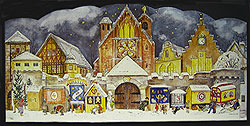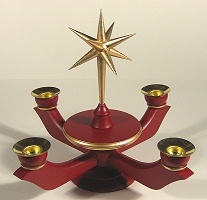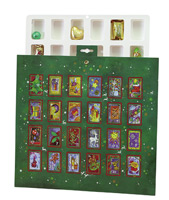Advent - Christkindlmarkt and Christmas Traditions
Advent - Christkindlmarkt and Christmas Traditions
The word "Advent" means "the coming." It refers to a period of time where people of Catholic and Protestant faiths look back on the first coming of the Christ and forward at a "second" coming. Advent is a period of time preceding Christmas where one anticipates the birth of the Christ child and looks forward to Christmas day. Originally, the Season of Advent was celebrated for six weeks, beginning the last week of November. The acceptable period of Christmas shopping traditionally coincided with the older Season of Advent. In modern times however, the period of Advent is celebrated for the four Sundays before Christmas day and shopping fro the Christmas Holidays has crept earlier and earlier on the calendar, far exceeding the Advent weeks. In 2006, Advent began on December 3rd and the following Sundays, the 10th, 17th, & 24th would all have traditions acknowledging the day and counting down to Christmas. In 2007 the dates of Advent will be: December 2nd ,9th ,16th ,& 23rd.

The period of Advent has been celebrated since the fourth century and has the custom of lighting a candle ring/wreath. There is a lot of symbolism in the Advent traditions. When one looks at the Advent wreath they will see four different candles, three of which are blue or purple and one is a rosy pink color. They are imbedded in a circular wreath of evergreen boughs and, in recent years, candleholders have been designed in wood to hold the advent candles and tell the advent story. The symbols of the advent wreath are as follows:
- Wreath: It is made of evergreen boughs symbolizing the eternity of God; just as the tree is always green, God is always God. The wreath is in a circle representing the cycle of life; there was an advent in the past – what we now celebrate as Christmas – and there will be an advent in the future. The evergreen boughs also remind us of the holiday season and Christmas.
- Four candles: These as a whole represent the four weeks of anticipation for the holiday season. Advent is celebrated for twenty-four days and a candle is lit for each new week in that period. They also as candles, represent the light of hope for renewal and for the Christ child.
- Blue or Purple Candles: These candles were traditionally purple, reminiscent of the period lent where churchgoers fasted in anticipation for the death of Christ. In history, Christmas once had a solemn mood – as the arrival of the Christ child to the world was a serious matter. However, more recently, the color blue and even white has been used. It represents the hope and joy of the Christmas season.

- First Candle: This candle is typically purple/blue and is called the "Hope" candle. It reminds us of the hope that existed prior to Christ, that a savior was coming. This candle is also called the candle of prophesy and liturgy is read of the old prophets predicting the Christ Child’s arrival.
- Second Candle: This candle is also purple/blue and it is called the candle of love. It reminds us of the love that the Christ Child has for the world and the love that fills this joyous season.
- Third Candle: This candle is pink or rose colored. It is called the "Joy" candle and reminds us of the joy that exists during the holidays. Liturgy is read today reminding us of the Shepherds and the joy they must have felt with the arrival of the Christ Child.
- Fourth Candle: This candle once again is purple/blue. It is the last candle to be lit. It symbolizes the peace that the Christ Child brought to the earth.
- White Candle: On Christmas day, or during the evening mass the night before, a white column candle is placed in the middle of the wreath and is lit reminding us that Christ arrived on earth in the form of a baby. This is usually nativity scenes are brought out and the baby Jesus story is told. Other advent candleholders, like the one shown here, instead of placing a candle in the middle, they replace all of the colored candles with white ones. This also symbolizes the arrival of Christ and Christmas.
During the period of Advent, when Christmas was a new holiday, small gifts were to be given out to loved ones. In Germany, the period of Advent coincides with the Christkindlmarkt – or Christ Child Markets. Here one can shop for handcrafted figurines, toys, candle carousels or pyramids, incense smokers, nutcrackers, etc. Christkindl markets and the period of Advent has been a factor in creating a holiday with the tradition of gift-giving became associated with Christmas.

Since the beginning of the 20th century another Advent tradition has been born. This one is especially popular with children of all ages. There are twenty-four days leading up to Christmas, during the period of Advent. Colorful calendars have been made with little windows. The first of these was created in Germany. One window is opened each day leading up to the Holidays. Hidden behind the window in the card is an image. Sometimes these images remind the children of a part of the Christmas nativity. Other times the images remind the child of an action or a feeling that the Holidays bring, like giving presents or going for sleigh rides. Many Advent calendars offer objects instead of images. When the child opens the window, they may see a nut, reminding them of seeds and growth. Other windows may have small candies or Christmas ornaments reminding the children that the holidays are filled with joy.
The Advent is a time of anticipation, whether you use a candle wreath or a calendar to look forward to the holiday season. All of us enjoy something that we spend time hoping for; remember to share the spirit of joy and of hope during this Christmas season.
